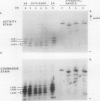Abstract
Three lipoxygenase isozymes are synthesized in developing soybean (Glycine max [L.] Merr. cv Williams) embryos and are found in high levels in cotyledons of mature seeds (B Axelrod, TM Cheesbrough, S Zimmer [1981] Methods Enzymol 71: 441-451). Upon germination at least two new protein species appear which are localized mainly (on a protein basis) in the hypocotyl/radicle section. These lipoxygenase species appear also in seedlings of each of three lipoxygenase nulls (1×1, 1×2, and 1×3) deficient in one of the dormant seed lipoxygenases. The germination-associated species are distinguishable from dry seed lipoxygenase by their more acidic isoelectric points as revealed in isoelectric focusing gels. They are active from as early as 2 to at least 5 days after the start of imbibition. These germination-stimulated species qualify as lipoxygenase by their inhibition by the lipoxygenase inhibitors n-propyl gallate and salicyl hydroxamic acid and their lack of inhibition by KCN. Further, they are not active on the peroxidase substrate pair H2O2/3-amino-9-ethyl carbazole. They are recognized on Western blots by polyclonal antibodies to the seed lipoxygenase-1 isozyme and the major induced species has a molecular weight of approximately 100,000, similar to that of the cotyledon lipoxygenases. These lipoxygenases appear to be synthesized de novo upon germination since they comigrate with radioactive protein species from seeds germinated in [35S]methionine.
Full text
PDF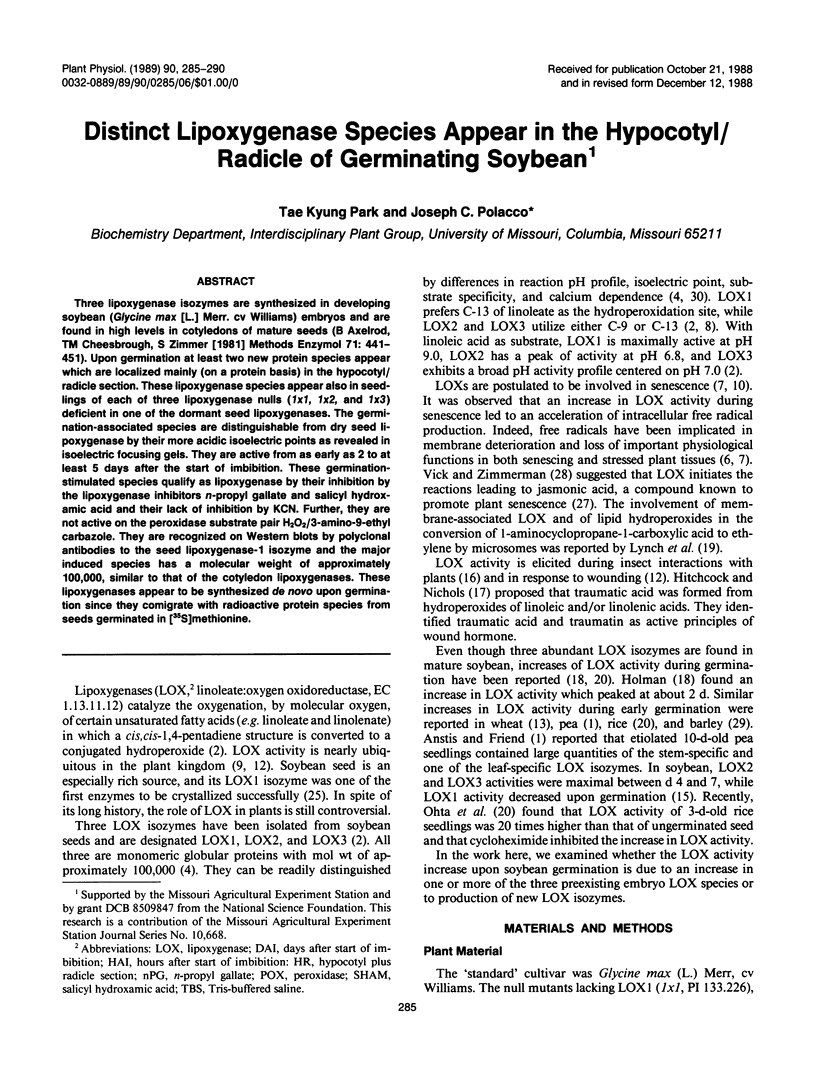
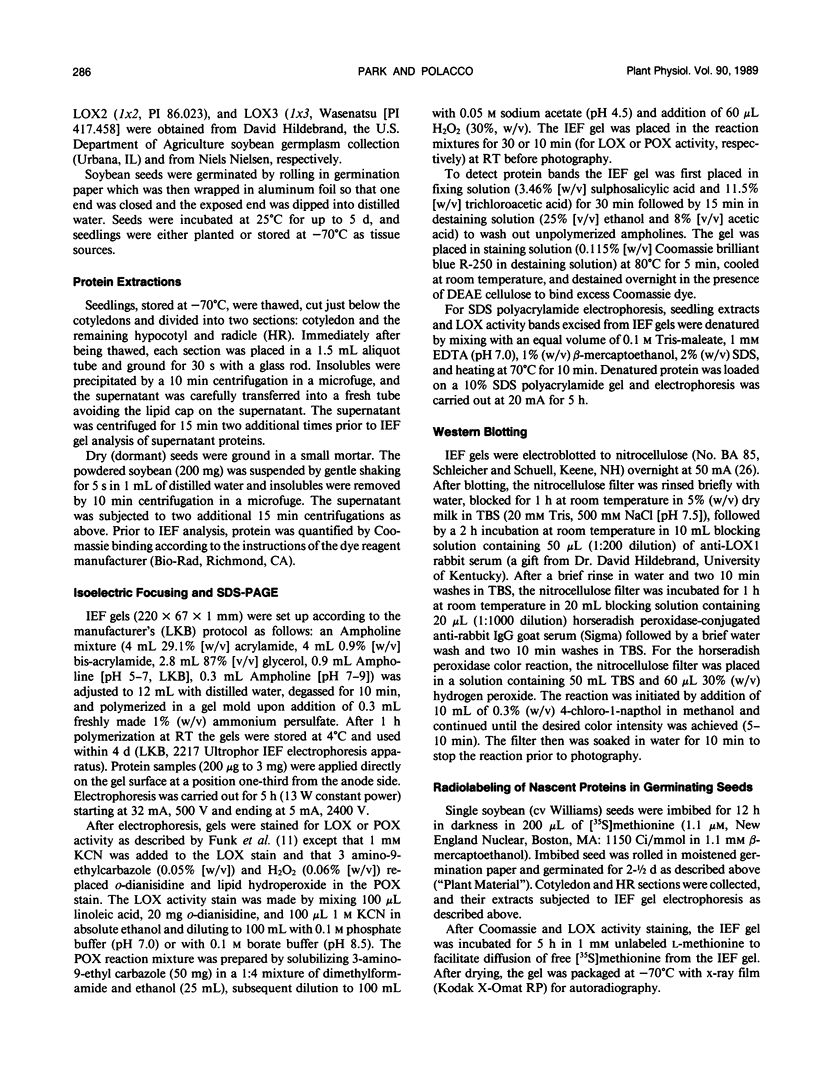
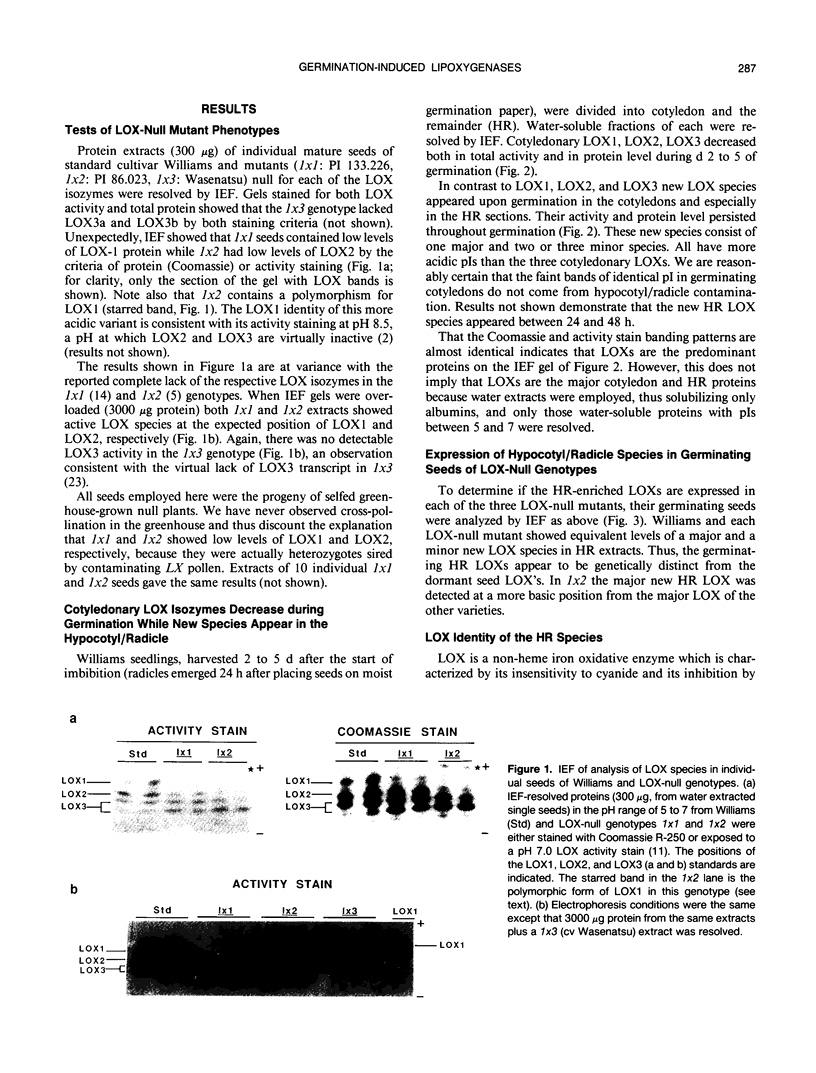
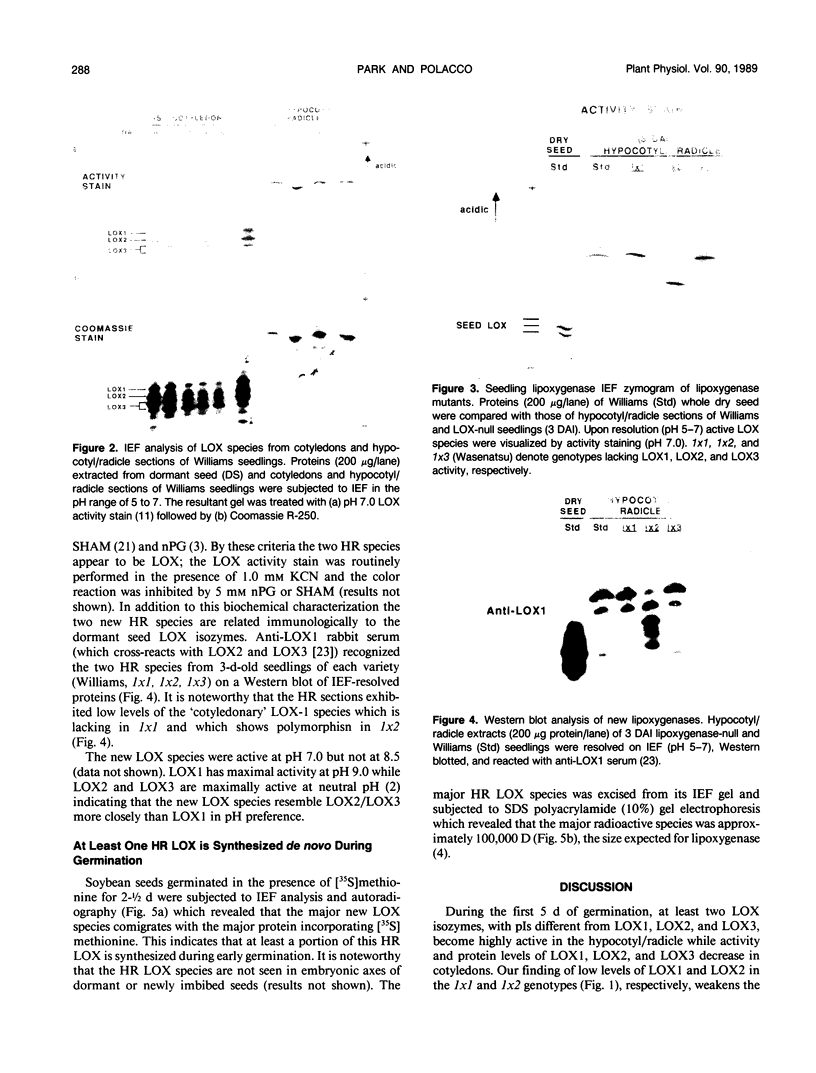
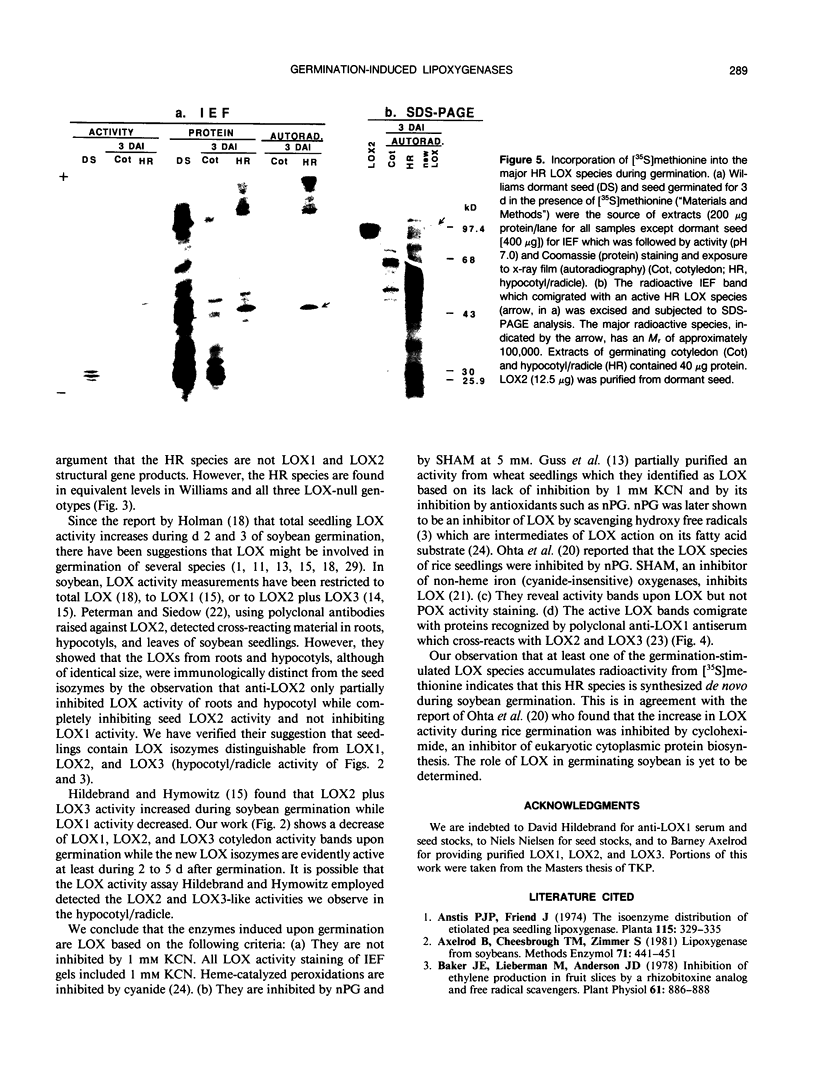
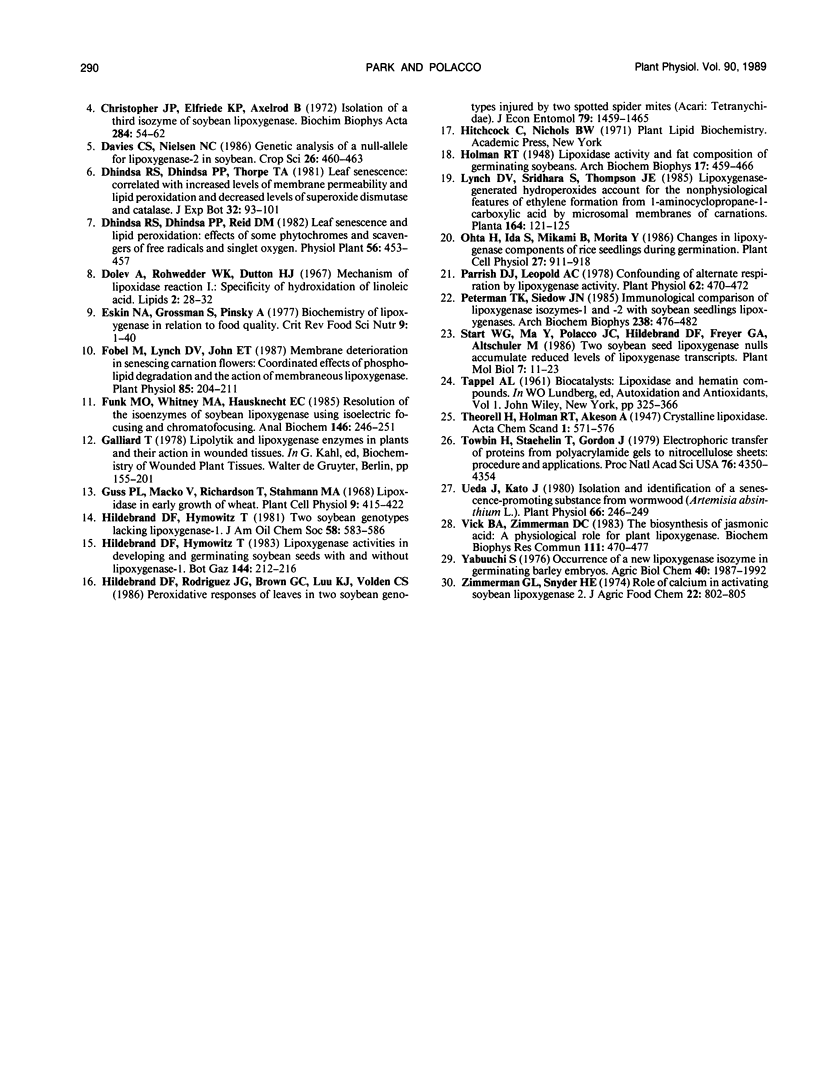
Images in this article
Selected References
These references are in PubMed. This may not be the complete list of references from this article.
- Baker J. E., Lieberman M., Anderson J. D. Inhibition of ethylene production in fruit slices by a rhizobitoxine analog and free radical scavengers. Plant Physiol. 1978 Jun;61(6):886–888. doi: 10.1104/pp.61.6.886. [DOI] [PMC free article] [PubMed] [Google Scholar]
- Christopher J. P., Pistorius E. K., Axelrod B. Isolation of a third isoenzyme of soybean lipoxygenase. Biochim Biophys Acta. 1972 Sep 19;284(1):54–62. doi: 10.1016/0005-2744(72)90045-9. [DOI] [PubMed] [Google Scholar]
- Dolev A., Rohwedder W. K., Dutton H. J. Mechanism of lipoxidase reaction. I. Specificity of hydroperoxidation of linoleic acid. Lipids. 1967 Jan;2(1):28–32. doi: 10.1007/BF02531996. [DOI] [PubMed] [Google Scholar]
- Eskin N. A., Grossman S., Pinsky A. Biochemistry of lipoxygenase in relation to food quality. CRC Crit Rev Food Sci Nutr. 1977 Apr;9(1):1–40. doi: 10.1080/10408397709527229. [DOI] [PubMed] [Google Scholar]
- Fobel M., Lynch D. V., Thompson J. E. Membrane deterioration in senescing carnation flowers : coordinated effects of phospholipid degradation and the action of membranous lipoxygenase. Plant Physiol. 1987 Sep;85(1):204–211. doi: 10.1104/pp.85.1.204. [DOI] [PMC free article] [PubMed] [Google Scholar]
- Funk M. O., Whitney M. A., Hausknecht E. C., O'Brien E. M. Resolution of the isoenzymes of soybean lipoxygenase using isoelectric focusing and chromatofocusing. Anal Biochem. 1985 Apr;146(1):246–251. doi: 10.1016/0003-2697(85)90422-1. [DOI] [PubMed] [Google Scholar]
- Parrish D. J., Leopold A. C. Confounding of alternate respiration by lipoxygenase activity. Plant Physiol. 1978 Sep;62(3):470–472. doi: 10.1104/pp.62.3.470. [DOI] [PMC free article] [PubMed] [Google Scholar]
- Peterman T. K., Siedow J. N. Immunological comparison of lipoxygenase isozymes-1 and -2 with soybean seedling lipoxygenases. Arch Biochem Biophys. 1985 May 1;238(2):476–483. doi: 10.1016/0003-9861(85)90190-0. [DOI] [PubMed] [Google Scholar]
- Towbin H., Staehelin T., Gordon J. Electrophoretic transfer of proteins from polyacrylamide gels to nitrocellulose sheets: procedure and some applications. Proc Natl Acad Sci U S A. 1979 Sep;76(9):4350–4354. doi: 10.1073/pnas.76.9.4350. [DOI] [PMC free article] [PubMed] [Google Scholar]
- Ueda J., Kato J. Isolation and Identification of a Senescence-promoting Substance from Wormwood (Artemisia absinthium L.). Plant Physiol. 1980 Aug;66(2):246–249. doi: 10.1104/pp.66.2.246. [DOI] [PMC free article] [PubMed] [Google Scholar]
- Vick B. A., Zimmerman D. C. The biosynthesis of jasmonic acid: a physiological role for plant lipoxygenase. Biochem Biophys Res Commun. 1983 Mar 16;111(2):470–477. doi: 10.1016/0006-291x(83)90330-3. [DOI] [PubMed] [Google Scholar]
- Zimmerman G. L., Snyder H. E. Role of calcium in activating soybean lipoxygenase 2. J Agric Food Chem. 1974 Sep-Oct;22(5):802–805. doi: 10.1021/jf60195a006. [DOI] [PubMed] [Google Scholar]




